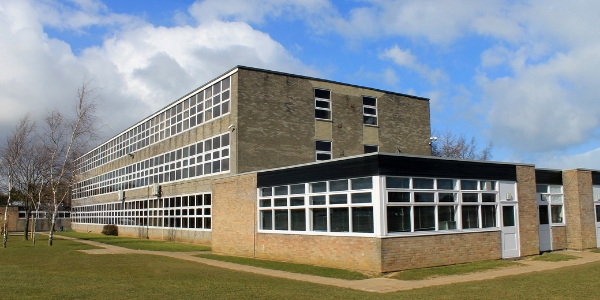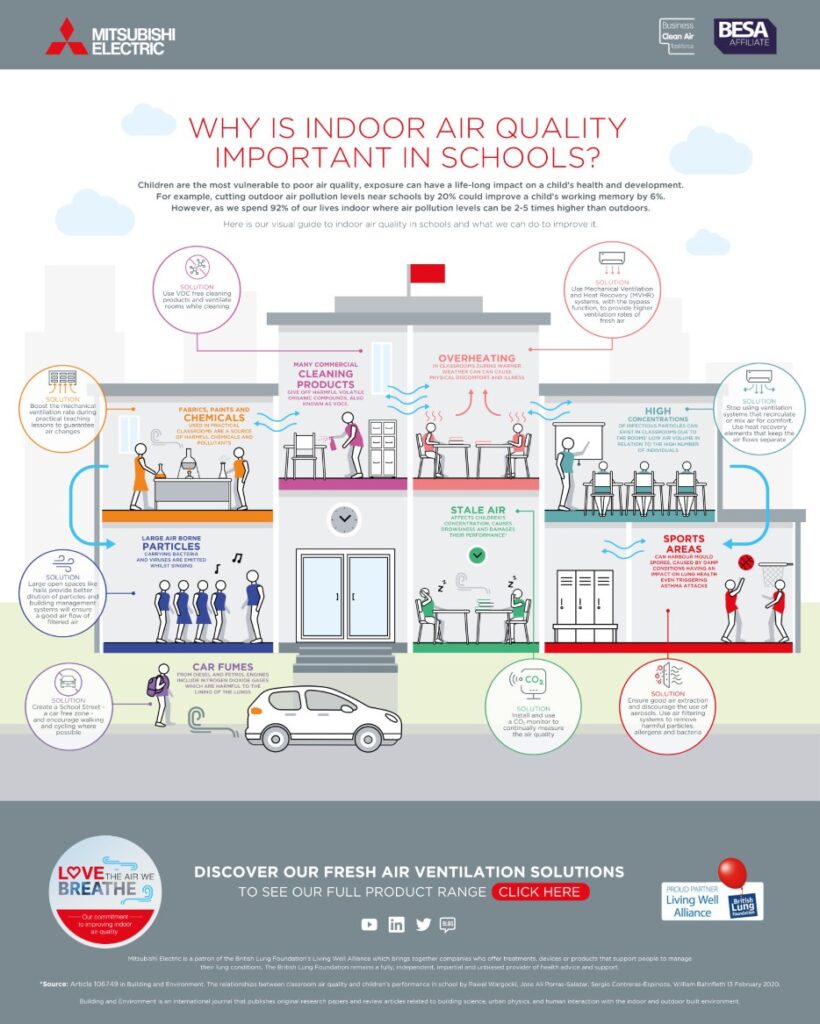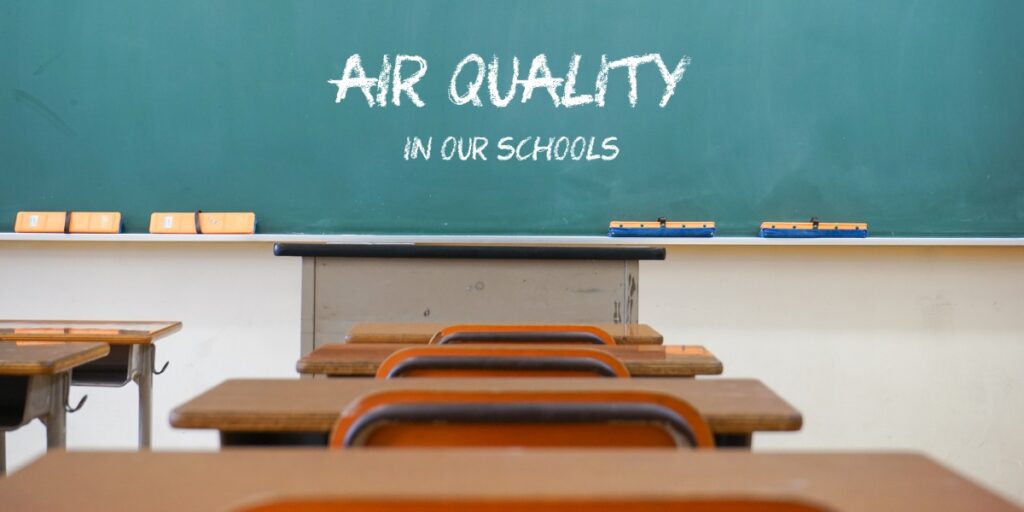Update – September 2021
According to the BBC, six education unions have written to England’s education secretary, warning of a steep rise in Covid and “long Covid” when pupils return to classes. These unions include the National Education Union (NEU), NASUWT, Association of School and College Leaders (ASCL), National Association of Head Teachers (NAHT), GMB, Unison and Unite.
Their demands include action on ventilation in schools and funding for carbon-dioxide monitors, to identify where ventilation is poor so that action may be taken, and micro-filters to remove harmful particles.
Disruption to schools will continue without real government funding and it needs to happen now. The idea of ventilating schools by keeping windows open is not an option for British winter periods.
The unions state that many thousands of teachers are are already suffering from long Covid, some school staff haven’t yet been double jabbed, or are in a vulnerable group.
Back to school
Thousands of children have now returned to some 24,500 schools across the UK. However, there is increased concern about how best to protect them, teachers, and parents within the schools from virus transmission. This can only be achieved by improving indoor air quality – a topic that the Covid-19 pandemic has brought sharply back into focus.
Indoor air quality refers to the air quality within and around buildings and structures that relate to the health and comfort of its occupants. It is mainly concerned with air pollutants from gasses, such as carbon dioxide (CO2), and volatile organic compounds (VOCs), which can be emitted from things such as paints, deodorants, furniture etc.
The provision of good indoor air quality is important for both health and maximising educational achievement. The Building Engineering Services Association (BESA) believes that school buildings have been under-invested in for decades. Many schools are in a state of disrepair, they rely on natural ventilation and don’t necessarily have the funds to change this – meaning schools are unable to have control over the quality of the air pupils or staff breathe.
Classroom productivity
Whilst more research has been carried out on workplaces in relation to indoor air quality and its impact on productivity, children and classrooms cannot be ignored as they can also still suffer with high levels of CO2. According to research by Global Action Plan, the Philips Foundation and University of Manchester, reducing air pollution levels near schools by 20% could improve a child’s working memory by 6% – the equivalent of 4 weeks extra learning a year.
In our February blog we wrote about the impact of high levels of CO2 and the results on its occupants if not managed. As a general guide CO2 levels for a healthy good learning environment should be around 400 to 1000 parts per million (PPM), below shows what may happen if this level is not controlled:

Health effects of indoor air quality on children
In addition to the impact of indoor air quality on productivity, a starker fact is according to the government, air pollution is the 4th biggest killer in the UK after cancer, obesity, and heart disease.
Poor indoor air quality may cause odours or irritability, it may aggravate symptoms such as allergies and asthma, airborne respiratory infections, chronic obstructive pulmonary disease, cardiovascular disease and lung cancer (IAQ Indoor Air Quality Guidelines for selected VOCs). The effects caused can be far reaching and diverse and of course can depend on an individual’s pre-existing health conditions. The effects can be seen immediately or can have long term impacts.
Natural ventilation is not enough
Whilst natural ventilation is better than none, natural ventilation is not the right solution. Imagine a school in a built up area – opening windows could let in potentially harmful pollutants from the outside in. Nathan Wood, chair of BESA’s Health & Wellbeing in Buildings group said, “Opening windows gives you no control over the direction of the outside air and no opportunity to filter it to remove potentially harmful pollutants coming in from outside.”
Neither does it meet the requirement of becoming carbon neutral – opening windows in the colder months will just lead to heating being wasted, not to mention freezing school children!
It can neither be guaranteed that natural ventilation will provide the air change rates needed to reduce the risk of transmitting the virus between teachers, children, and parents.
Cath Noakes, Scientific Advisory Group for Emergencies (SAGE) member and building ventilation specialist, said that ‘engineered solutions’ should be above measures that rely on human behaviour such as social distancing and wearing face coverings. It was also countered by fellow SAGE member, Professor Calum Semple, from the University of Liverpool, who said “if I had to invest in a single activity to improve the environment for both children and adults, I’d be looking at improving the ventilation”.

And breathe….
BESA has stated it is time now to be thinking about mechanical ventilation solutions that can help to tackle future health crises and allow schools to be able to effectively manage the quality of the indoor air across thousands of classrooms.
The two most important elements needed to be considered is that schools need a mechanical ventilation solution that is simple for them to operate and manage, and one that is cost effective for their needs.
Providing schools with the ability to control their own indoor environments for the benefit of their children and teachers is the priority. Graeme Fox, BESA’s head of technical, said “Engineered solutions will be essential in demonstrating that a building is safe now and will be safe when the next public health emergency hits,”. “If central and local government do not believe this is worth investing in now, when we are fighting a deadly airborne virus, then you have to ask: “When?”.

The Department for Education (DfE) has started on a school rebuilding programme backed by £7bn worth of funding over the next 10 years. This will focus on a commitment to rebuild 500 schools in England over the next decade.
The first 50 projects of the programme have been announced and include primary, secondary and special schools. Another 50 projects will be added to the programme this year. In addition to this the government has committed to allocate £1.8 billion for school repair and upgrade projects over this coming year.
Ultimately, local authorities, academy trusts and others responsible for school buildings conduct their own assessments of the condition of school buildings. So, if you feel your school is in poor condition it is vital to rally them to prioritise the investment of funding in your area.
Indoor air quality guidance
Public Health England (PHE) supports guidance from The Federation of European Heating, Ventilation and Air conditioning Associations (REHVA) on changing ventilation practices to reduce the risk of COVID-19 transmission. The Chartered Institution of Building Services Engineers is a United Kingdom member of REHVA and their advice is in line with REHVA guidance.
Mitsubishi Electric has also put together a useful infographic that shows how schools can provide good quality indoor air for children and teachers, from using volatile organic compound (VOCs) free cleaning products, to removing overheating using heat recovery systems to CO2 monitoring:

Schools indoor air quality – further reading
- A beginner’s guide to indoor air quality – by BESA and Mitsubishi Electric
- Opening windows will not protect schools – by BESA
- Building Bulletin 101: Guidelines on ventilation, thermal comfort, and indoor air quality in schools – by the Education and Skills Funding Agency
- Indoor Air Quality in Schools – by Mitsubishi (infographic)
- Covid-19 Guidance – The Federation of European Heating, Ventilation and Air conditioning Associations (REHVA)
- Urgent call for Covid-safe ventilation in schools – BBC
How Lynx AC can help
Lynx AC are a first class provider of mechanical ventilation and heat recovery installations. We are a Mitsubishi Electric Diamond Quality Partner and a Daikin D1+ Premium Partner, which means you’ll get the best products with the best service for your school, children and teachers. We have designed and installed hundreds of solutions across a number of industries including schools and colleges.
Simply call us on 01522 788799 to discuss the solutions you could look at for your school or college.


